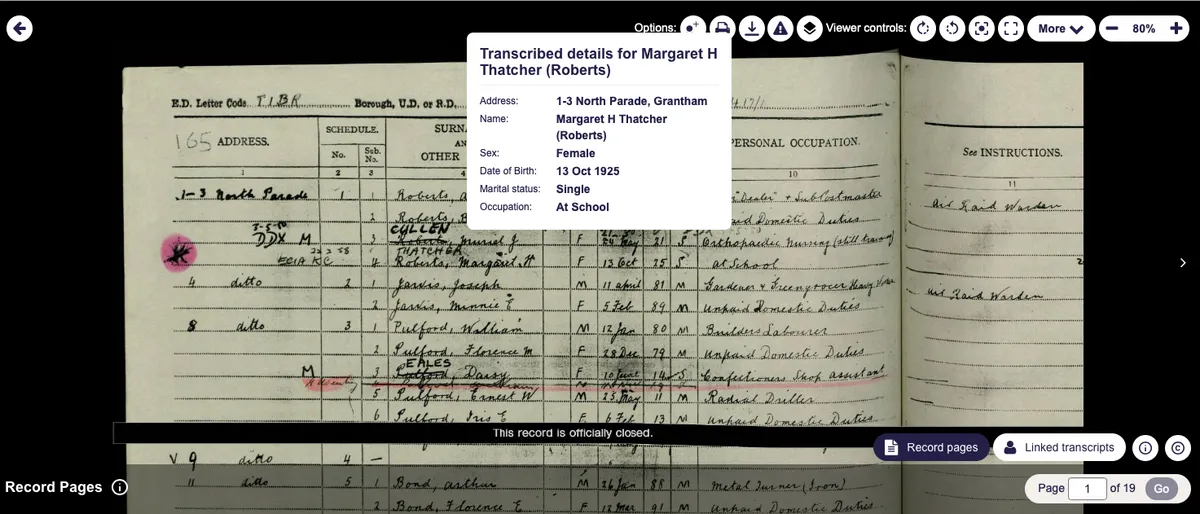The 1939 Register is the most recent major record set for English and Welsh family history. Following the start of the Second World War on 3 September 1939, the British government needed to conduct an accurate count of Britain’s civilian population to enable issuing of ration books and ID cards, the direction of labour and conscription into the armed forces. The 1939 Register is therefore the most complete snapshot available of the English and Welsh population on the eve of war. It lists the names, addresses and other details of over 45 million people. The original 7000 volumes of the 1939 Register are held at The National Archives.
When was the 1939 Register taken?
How to access the 1939 Register
What will the 1939 Register tell you?
Why is the 1939 Register important?
Why are some records closed on the 1939 Register?
How can you access the 1939 Register for Scotland and Northern Ireland?
When was the 1939 Register taken?
The 1939 Register was taken on 29 September 1939.
How to access the 1939 Register
The 1939 Register is available on subscription genealogy websites Ancestry, Findmypast, TheGenealogist and MyHeritage. Both TheGenealogist and MyHeritage only offer the transcription at present, with no images. The transcription they use is the same as the one used by Findmypast. Ancestry uses its own transcription along with images.
What will the 1939 Register tell you?
1939 Register records are very similar to census records. The records list each resident of each household in England and Wales and give each individual’s full name; address; date of birth; marital status; occupation; and whether the individual was a member of the armed services or reserves.
However, there are some differences from census records. Unlike the census, the 1939 Register does not give the person’s place of birth. However, it does give their exact date of birth, rather than their age, which can make it easier to find your ancestor’s civil birth record. Unlike the census, the 1939 Register also includes the full name and details of people in prison or other institutions.
The 1939 Register was continually updated while National Registration was in force, and continued to be used by the National Health Service after the war. The records were regularly updated until 1991. If a woman in the 1939 Register married or remarried after the records were taken, the records have been amended to include her married name. Some other 1939 Register records have also been amended in a similar way - for example, Winston Churchill's record lists his occupation as '1st Lord of the Admiralty', but this was changed to 'Prime Minister' when he took office the following year.

Note that although the 1939 Register says whether an individual was a member of the armed forces or reserves, those on active duty in the military were not included in the headcount, even if they were billeted in the household and were there on the night of the headcount.
As well as family history, you can search the 1939 Register by a street name on Findmypast and TheGenealogist and use it to help compile a house history.
Why is the 1939 Register important?
The 1939 Register is particularly important for family historians because the 1931 census for England and Wales was destroyed in the Blitz, and there was no census taken in 1941. The 1939 Register is therefore the closest thing to a national census available between the 1921 census and the 1951 census, which will be released in 2052.
Why are some records closed on the 1939 Register?
You will see some records covered by a black line in the 1939 Register. These are the records of individuals who were born less than 100 years ago and whose death has not been registered. This is to protect their privacy if they are still alive. TheGenealogist, Findmypast and Ancestry regularly update their 1939 Register collections to include more individuals as they become eligible.
If a family member who is deceased is wrongly redacted from the 1939 Register, you can ask Findmypast to change it, although this will require submitting proof of death. Alternatively, you can request their record by submitting a Freedom of Information request to The National Archives. This will cost £24.35.
How can you access the 1939 Register for Scotland and Northern Ireland?
The 1939 Register records for Scotland and Northern Ireland are not available online. For a Scottish 1939 Register record, you will need to apply via post to the National Records of Scotland. This will cost £15 although this is reduced to £5 if an entry cannot be found. For 1939 Register records from Northern Ireland, you will need to submit a Freedom of Information request to the Public Record Office of Northern Ireland (PRONI). Because of the collapse of the Stormont Executive in Northern Ireland, PRONI is currently unable to fulfil these requests until a new Minister of Communities is appointed.